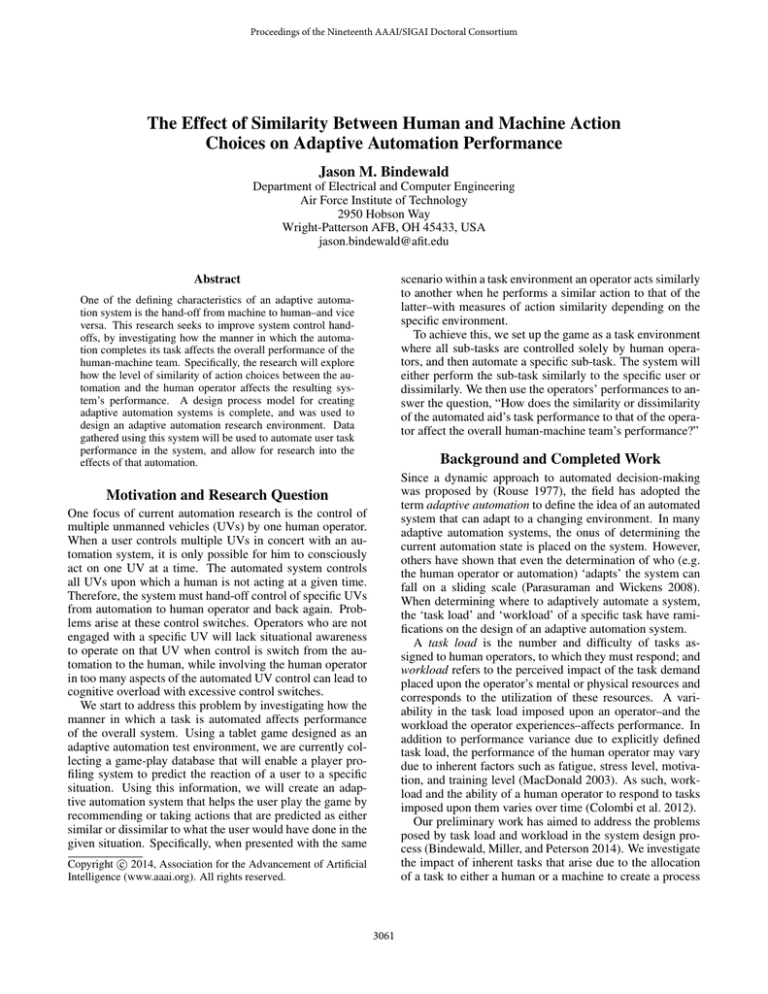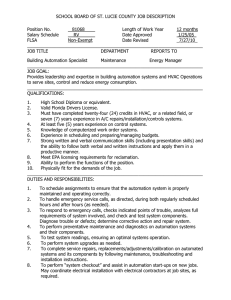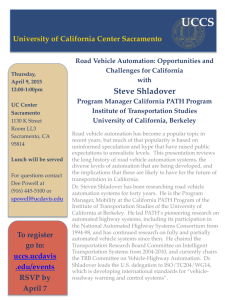
Proceedings of the Nineteenth AAAI/SIGAI Doctoral Consortium
The Effect of Similarity Between Human and Machine Action
Choices on Adaptive Automation Performance
Jason M. Bindewald
Department of Electrical and Computer Engineering
Air Force Institute of Technology
2950 Hobson Way
Wright-Patterson AFB, OH 45433, USA
jason.bindewald@afit.edu
Abstract
scenario within a task environment an operator acts similarly
to another when he performs a similar action to that of the
latter–with measures of action similarity depending on the
specific environment.
To achieve this, we set up the game as a task environment
where all sub-tasks are controlled solely by human operators, and then automate a specific sub-task. The system will
either perform the sub-task similarly to the specific user or
dissimilarly. We then use the operators’ performances to answer the question, “How does the similarity or dissimilarity
of the automated aid’s task performance to that of the operator affect the overall human-machine team’s performance?”
One of the defining characteristics of an adaptive automation system is the hand-off from machine to human–and vice
versa. This research seeks to improve system control handoffs, by investigating how the manner in which the automation completes its task affects the overall performance of the
human-machine team. Specifically, the research will explore
how the level of similarity of action choices between the automation and the human operator affects the resulting system’s performance. A design process model for creating
adaptive automation systems is complete, and was used to
design an adaptive automation research environment. Data
gathered using this system will be used to automate user task
performance in the system, and allow for research into the
effects of that automation.
Background and Completed Work
Since a dynamic approach to automated decision-making
was proposed by (Rouse 1977), the field has adopted the
term adaptive automation to define the idea of an automated
system that can adapt to a changing environment. In many
adaptive automation systems, the onus of determining the
current automation state is placed on the system. However,
others have shown that even the determination of who (e.g.
the human operator or automation) ‘adapts’ the system can
fall on a sliding scale (Parasuraman and Wickens 2008).
When determining where to adaptively automate a system,
the ‘task load’ and ‘workload’ of a specific task have ramifications on the design of an adaptive automation system.
A task load is the number and difficulty of tasks assigned to human operators, to which they must respond; and
workload refers to the perceived impact of the task demand
placed upon the operator’s mental or physical resources and
corresponds to the utilization of these resources. A variability in the task load imposed upon an operator–and the
workload the operator experiences–affects performance. In
addition to performance variance due to explicitly defined
task load, the performance of the human operator may vary
due to inherent factors such as fatigue, stress level, motivation, and training level (MacDonald 2003). As such, workload and the ability of a human operator to respond to tasks
imposed upon them varies over time (Colombi et al. 2012).
Our preliminary work has aimed to address the problems
posed by task load and workload in the system design process (Bindewald, Miller, and Peterson 2014). We investigate
the impact of inherent tasks that arise due to the allocation
of a task to either a human or a machine to create a process
Motivation and Research Question
One focus of current automation research is the control of
multiple unmanned vehicles (UVs) by one human operator.
When a user controls multiple UVs in concert with an automation system, it is only possible for him to consciously
act on one UV at a time. The automated system controls
all UVs upon which a human is not acting at a given time.
Therefore, the system must hand-off control of specific UVs
from automation to human operator and back again. Problems arise at these control switches. Operators who are not
engaged with a specific UV will lack situational awareness
to operate on that UV when control is switch from the automation to the human, while involving the human operator
in too many aspects of the automated UV control can lead to
cognitive overload with excessive control switches.
We start to address this problem by investigating how the
manner in which a task is automated affects performance
of the overall system. Using a tablet game designed as an
adaptive automation test environment, we are currently collecting a game-play database that will enable a player profiling system to predict the reaction of a user to a specific
situation. Using this information, we will create an adaptive automation system that helps the user play the game by
recommending or taking actions that are predicted as either
similar or dissimilar to what the user would have done in the
given situation. Specifically, when presented with the same
c 2014, Association for the Advancement of Artificial
Copyright Intelligence (www.aaai.org). All rights reserved.
3061
Future Work and Expected Contribution
1
Determine
over-arching
goal
7
A similarity measure similar to Modified Hausdorff Distance (Atev, Masoud, and Papanikolopoulos 2006), called
Windowed Hausdorff Distance, has been developed in order to compare trajectories of different lengths. Coupling
this similarity measure with the player profiling system will
form the base of an adaptive automation system to play
Space Navigator. Other researchers at the Air Force Institute
of Technology (AFIT) are working on creating workloadbased adaptive automation triggers specific to the environment. This research, combined with the function-to-task design process model results will allow the creation of an adaptive automated version of Space Navigator that aids human
performers on one specific sub-task within the environment.
The resultant system and experiments based on it will allow us to answer the research question. Our research has already provided a new adaptive automation design model, allowing system designers the ability to visually and systematically evaluate the placement of adaptive automation within
a system network. The Space Navigator platform designed
using the model, has allowed us (and future researchers) to
simplify the data gathering process. The resulting automation system will allow for research into how similarity and
difference of actions between a human-machine team affect
the overall performance of the system. The final experimental data will provide several areas of further research including trust in automation, training improvement, workload reduction (actual and perceived), and task load switching.
2
Identify
high-level
functions
Define
adaptive
automation
states
6
Separate
inherent
tasks
3
Decompose
functions
4
Construct
function
relationship
diagram
5
Instantiate
functions to
tasks
Begin
End
Primary Path
Revisions
Figure 1: The Function-to-Task Design Process Model for
adaptive automation system design (Bindewald, Miller, and
Peterson 2014).
for designing adaptive automation. The resulting functionto-task design process model (see Figure 1) utilizes a set
of visual diagrams to identify areas for adaptive automation
within a human-machine system. This is achieved through
a seven-step process allowing designers to identify points
within a function network where the transitions between human and machine entities can facilitate adaptive automation.
Using the function-to-task design process model, we created an environment for investigating adaptive automation.
The resulting system is a tablet-based game called Space
Navigator where the operator draws trajectories on the
screen in order to interact with the system. One of the goals
of the designed system was to simplify the data collection
process by “gamifying” the system (Hamari, Koivisto, and
Sarsa 2014), using a portable tablet computer for gathering
data, and writing an open-source system that can be easily
ported to different types of devices.
References
Atev, S.; Masoud, O.; and Papanikolopoulos, N. 2006.
Learning traffic patterns at intersections by spectral clustering of motion trajectories. In Intelligent Robots and Systems, 2006 IEEE/RSJ International Conference on, 4851–
4856. IEEE.
Bindewald, J. M.; Miller, M. E.; and Peterson, G. L. 2014.
A function-to-task process model for adaptive automation
system design. [SUBMITTED FOR PUBLICATION].
Colombi, J.; Miller, M.; Schneider, M.; McGrogan, J.;
Long, D.; and Plaga, J. 2012. Predictive mental workload
modeling for semi-autonomous system design: Implications
for systems of systems. Journal of Systems Engineering
15(4):448–460.
Hamari, J.; Koivisto, J.; and Sarsa, H. 2014. Does gamification work?a literature review of empirical studies on gamification. In Proceedings of the 47th Hawaii International
Conference on System Sciences. HICSS.
MacDonald, W. 2003. The impact of job demands and
workload on stress and fatigue. Australian Psychologist
38(2):102–117.
Parasuraman, R., and Wickens, C. D. 2008. Humans: Still
vital after all these years of automation. Human Factors
50(3):511–520.
Rouse, W. B. 1977. Human-computer interaction in multitask situations. Systems, Man and Cybernetics, IEEE Transactions on 7(5):384–392.
Current Work
A recently completed data-collection experiment has facilitated the creation of a game-play database. The next step in
determining how similarity of action affects human-machine
system performance is to create a computational system to
mimic human game-play patterns. The objective of this
study is to see to what extent we can distinguish between
specific players of the game. Presently, we are working to
take the game-play database and use it to create a player profiling system.
Preliminary results have shown us that a player-by-player
discernment is not feasible, but that player profiles can be
created to discern between larger groups of players with specific tendencies. An unsupervised learning system will be
used to cluster users according to a k-means clustering algorithm, and a Fisher score supervised feature selection algorithm is applied to determine what defines different clusters
of users. The efforts to complete the player profiling system
will be completed over the summer of 2014.
3062








